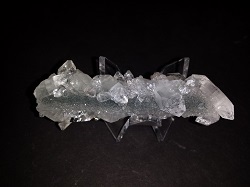A- |
B- |
C- |
D- |
E- |
F- |
G- |
H- |
I- |
J- |
K- |
L- |
M- |
N- |
O- |
P- |
Q- |
R- |
S- |
T- |
U- |
V- |
W- |
X- |
Y- |
Z |
APOPHYLLITE:PHYSICAL CHARACTERISTICS:Color is clear, white, green, yellow, pink, violet or rarely brown. Luster is vitreous to pearly on cleavage surfaces. Transparency: Crystals are transparent to translucent. Crystal System is tetragonal; 4/m 2/m 2/m; natroapophyllite is orthorhombic, 2/m 2/m 2/m. Crystal Habits include four sided prisms (with a square cross-section) truncated with either a steep four sided pyramid or a pinacoid termination or both. If the pyramids are missing, the crystals can look cubic. Rarely are the prisms missing, but if they are, crystals could appear octahedral because of the four sided pyramids. The faces of the pyramids do not lineup with the prism faces but with their edges, therefore the pyramid faces have four edges and appear diamond shaped instead of triangular like the pyramid faces of quartz. Rare tabular hydroxyapophyllite crystals are also known. Cleavage is perfect in one direction (basal). Fracture is uneven. Hardness is 4.5 - 5. Other Characteristics: Prism faces are striated lengthwise, some specimens are fluorescent and crystals will flake when heated.
Apophyllite, whose name roughly means "to leaf apart" in Greek, is a mineral classic. It was given its name because crystals tend to peel or flake apart when they are heated due to the loss of water molecules. Although not that well-known by the general public, apophyllite is quite popular among mineral collectors. It is probably the first exotic mineral that a young collector will own after filling up on specimens of calcite, quartz, pyrite, galena, mica, fluorite, gypsum, apatite, etc, etc. After these common minerals, apophyllite seems like a real rarity and it offers so much to the collector. It has beauty, pastel colors, a bright luster, interesting well formed habits, unusual associations with other exotic minerals and recently large amounts of quality specimens have become available at amazingly low prices compared to twenty years ago. What more could a collector want in a mineral? Unfortunately, apophyllite is not a mineral! Not officially, at least. Apophyllite is a general term for three official minerals that are similar in their chemistry and physical properties. Apophyllite is not the only mineral . . . non-mineral that this has happened to: see these non-minerals: apatite, olivine, serpentine and chlorite. Below is a comparison of the three official apophyllite minerals. Its wonderful associations are nice, but apophyllite is more often than not the star attraction. What makes apophyllite so popular among collectors is its fantastic crystals with their gem-like vitreous to pearly luster. Apophyllite almost always forms good crystals of two major types. The favorite crystal habit is the rectangular prism capped by a steep four sided pyramid (tetragonal dipyramid). A doubly terminated crystal is exceptionally special. The faces of the pyramids are rotated 45 degrees with respect to the prism faces and so plunge down into the prism edges. This produces a diamond-shaped pyramidal face instead of a typical triangular pyramid face such as on quartz. The shape is an extraordinary example of tetragonal crystal form. Although normally colorless or white, colored examples of apophyllite are always treasured. By far its most impressive color is the pastel green color that augments specimens from Poona, India. Some crystals of apophyllite are cut as gems, but mostly just for collectors. |

